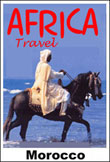|
About
Morocco, North Africa
Background
 The
Kingdom of Morocco is located in Northern Africa,
bordering the Atlantic Ocean and the Mediterranean
Sea. Slightly larger than California, with a
similar lengthy coastline (3,500 km) and separated
from Europe by the strait of Gibraltar, Morocco is
one of Africa's top five travel destinations. The
country has a population of over 30,600,000, and
while Arabic is the official language, French is
often the language of business, government and
diplomacy. Morocco received its independence from
France in 1956. (see
map) The
Kingdom of Morocco is located in Northern Africa,
bordering the Atlantic Ocean and the Mediterranean
Sea. Slightly larger than California, with a
similar lengthy coastline (3,500 km) and separated
from Europe by the strait of Gibraltar, Morocco is
one of Africa's top five travel destinations. The
country has a population of over 30,600,000, and
while Arabic is the official language, French is
often the language of business, government and
diplomacy. Morocco received its independence from
France in 1956. (see
map)
Area:
total: 446,550 sq km; land: 446,300 sq km
Climate: Mediterranean, becoming more
extreme in the interior
Terrain:
northern coast and interior are mountainous with
large areas of bordering plateaus, intermontane
valleys, and rich coastal plains
Elevation
extremes: lowest point: Sebkha Tah -55 m ;
highest point: Jbel Toubkal 4,165 m
Natural
resources: phosphates, iron ore, manganese,
lead, zinc, fish, salt
Land use:
arable land: 21% , permanent pastures: 47%
forests and woodland: 20% , Irrigated land: 12,580
sq km (1993 est.)
 Environment
- current issues: land degradation/desertification
(soil erosion resulting from farming of marginal
areas, overgrazing, destruction of vegetation);
water supplies contaminated by raw sewage;
siltation of reservoirs; oil pollution of coastal
waters Environment
- current issues: land degradation/desertification
(soil erosion resulting from farming of marginal
areas, overgrazing, destruction of vegetation);
water supplies contaminated by raw sewage;
siltation of reservoirs; oil pollution of coastal
waters
Environment -
international agreements: party to:
Biodiversity, Climate Change, Desertification,
Endangered Species, Hazardous Wastes, Marine
Dumping, Nuclear Test Ban, Ozone Layer Protection,
Ship Pollution, Wetlands, Whaling signed, but not
ratified: Environmental Modification, Law of the
Sea
Ethnic
groups: Arab-Berber 99.1%, other 0.7%, Jewish
0.2%
Religions:
Muslim 98.7%, Christian 1.1%, Jewish 0.2%
Languages:
Arabic (official), Berber dialects, French often
the language of business, government, and diplomacy
Government
type: constitutional monarchy
Capital:
Rabat

Administrative
divisions: 37 provinces and 2 wilayas*; Agadir,
Al Hoceima, Azilal, Beni Mellal, Ben Slimane,
Boulemane, Casablanca*, Chaouen, El Jadida, El
Kelaa des Srarhna, Er Rachidia, Essaouira, Fes,
Figuig, Guelmim, Ifrane, Kenitra, Khemisset,
Khenifra, Khouribga, Laayoune, Larache, Marrakech,
Meknes, Nador, Ouarzazate, Oujda, Rabat-Sale*,
Safi, Settat, Sidi Kacem, Tanger, Tan-Tan,
Taounate, Taroudannt, Tata, Taza, Tetouan, Tiznit .
note: three additional provinces of Ad Dakhla (Oued
Eddahab), Boujdour, and Es Smara as well as parts
of Tan-Tan and Laayoune fall within
Moroccan-claimed
Executive
branch: chief of state: King MOHAMED VI (since
23 July 1999)
head of
government: Prime Minister Abderrahmane
YOUSSOUFI (since 14 March 1998)
cabinet:
Council of Ministers appointed by the monarch
Diplomatic
representation in the US:
chief of mission: Ambassador Abdullah MAAROUFI
chancery: 1601 21st Street NW, Washington, DC
20009
telephone: [1] (202) 462-7979 through
7982
FAX: [1] (202) 265-0161
consulate(s) general: New York
Diplomatic
representation from the US:
Chief of mission: Ambassador Ms. Margaret DeB.
TUTWILER (since 11 Jul. 2001)
Embassy: 2 Avenue de Mohamed El Fassi,
Rabat
Mailing address: PSC 74, Box 3, APO AE 90718
telephone: [212] (37) 76 22 65
FAX: [212] (37) 76 56 61
Consulate(s)
general: Casablanca
Flag
description: red with a green pentacle
(five-pointed, linear star) known as Solomon's seal
in the center of the flag; green is the traditional
color of Islam
atural
hazards: northern mountains geologically
unstable and subject to earthquakes; periodic
droughts
Western Sahara;
decentralization/regionalization law passed by the
legislature in March 1997 creating many new
provinces/regions; specific details and scope of
the reorganization not yet available
Independence: 2
March 1956 (from France)
National
holiday: Throne Day (accession of King MOHAMED
VI to the throne), 30 July (1999)
Constitution: 10
March 1972, revised 4 September 1992, amended (to
create bicameral legislature) September 1996
Legal
system: based on Islamic law and French and
Spanish civil law system; judicial review of
legislative acts in Constitutional Chamber of
Supreme Court
Industries:
phosphate rock mining and processing, food
processing, leather goods, textiles, construction,
tourism
Agriculture
- products: barley, wheat, citrus, wine,
vegetables, olives; livestock
Exports: $7.6
billion (f.o.b., 2000 est.)
Currency:
Moroccan dirham (MAD) , Currency code: MAD
Exchange
rates: Moroccan dirhams per US dollar - 10.590
(January 2001), 10.626 (2000), 9.804 (1999), 9.604
(1998), 9.527 (1997), 8.716 (1996)
Exports - partners: France 35%, Spain 9%, UK
8%, Germany 7%, US 5% (1999) Imports: $12.2 billion
(f.o.b., 1999 est.) commodities: phosphates and
fertilizers, food and beverages, minerals
Imports -
partners: France 32%, Spain 12%, Italy 7%,
Germany 6%, UK 6% (1999) commodities: semiprocessed
goods, machinery and equipment, food and beverages,
consumer goods, fuel
Transportation
Railways:
total: 1,907 km. standard gauge: 1,907 km 1.435-m
gauge (1,003 km electrified; 540 km double-track)
(2001)
Highways:
total: 57,847 km
paved: 30,254 km
(including 327 km of expressways) , unpaved: 27,593
km (1998)
Ports and
harbors: Agadir, El Jadida, Casablanca, El Jorf
Lasfar, Kenitra, Mohammedia, Nador, Rabat, Safi,
Tangier; also Spanish-controlled Ceuta and Melilla
Airports:
69 (2000 est.)
Airports - with paved runways: total: 26
Heliports: 1 (2000 est.)
Radio broadcast stations: AM 27, FM 25,
shortwave 6 (1998), Radios: 6.64 million (1997)
Television
broadcast stations: 35 (plus 66 repeaters),
(1995) Televisions:3.1 million (1997)
Internet
country code: .ma
Internet
Service Providers (ISPs): 8 (2000)
Internet
users: 120,000 (1999)
Above details are
from World Factbook (US source)
Photo
Credit: Sheraton Fes, Morocco
|





